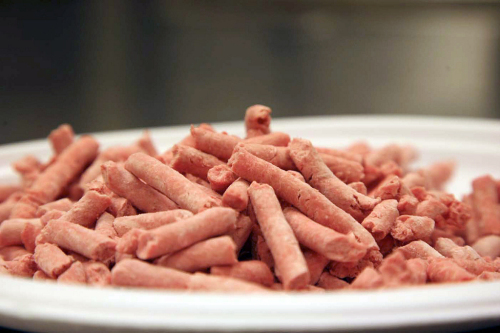
“Pink slime” just went from a simmer to a boil.
The stomach-turning epithet for ammonia-treated ground beef filler has suddenly become a potent rallying cry by activists fighting to ban the product from U.S. supermarket shelves and school lunch trays. The U.S. Department of Agriculture is set to announce Thursday it will offer schools choice in ground beef purchases in response to requests from districts.
Although the term has been used pejoratively for years _ celebrity chef Jamie Oliver has railed against it and McDonald’s discontinued its use of the product last year _ it wasn’t until last week that social media exploded with worry. An online petition seeking its ouster from schools lit up, quickly garnering hundreds of thousands of supporters.
“It sounds disgusting,” said food policy expert Marion Nestle, who notes that the unappetizing nickname made it easier for the food movement to flex its muscles over this cause.
“A lot of people have been writing about it. Therefore, more people know about it, therefore more people are queasy about it, particularly when you start thinking about how this stuff turns up in school lunches,” said Nestle, a professor at New York University’s Department of Nutrition, Food Studies and Public Health.
The controversy centers on “lean finely textured beef,” a low-cost ingredient in ground beef made from fatty bits of meat left over from other cuts. The bits are heated to about 100 Fahrenheit (37.8 Celcius) and spun to remove most of the fat. The lean mix then is compressed into blocks for use in ground meat. The product, made by South Dakota-based Beef Products Inc., also is exposed to “a puff of ammonium hydroxide gas” to kill bacteria, such as E. coli and salmonella.
It has been on the market for years and federal regulators say it meets standards for food safety. But advocates for wholesome food have denounced the process as a potentially unsafe and unappetizing example of industrialized food production.
The epithet “pink slime,” coined by a federal microbiologist, has appeared in the media at least since a critical 2009 New York Times report. It made headlines after McDonald’s and other major chains last year discontinued their use of ammonia-treated beef.
There are no precise numbers on how prevalent the product is and it does not have to be labeled as an ingredient. Past estimates have ranged as high as 70 percent; one industry official estimates it is in at least half of the ground meat and burgers in the United States.
“Pink slime” outrage seemed to reach new heights last week amid reports by The Daily and ABC News. The Daily piece dealt with the U.S. Department of Agriculture’s purchase of meat that included “pink slime” for school lunches.
The story touched a nerve with Houston resident Bettina Siegel, whose blog “The Lunch Tray” focuses on kids’ food. On March 6, she started an online petition on Change.org asking Agriculture Secretary Tom Vilsack to “put an immediate end to the use of ‘pink slime’ in our children’s school food.”
“When I put it up, I had this moment of embarrassment,” she said, “What if only 10 people sign this?”
No problem there. Supporters signed on fast. By Wednesday afternoon, the electronic petition had more than 220,000 signatures. Organizers of Change.org said the explosive growth is rare among the roughly 10,000 petitions started there every month.
The USDA _ which did not directly address Siegel’s petition _ buys about a fifth of the food served in schools nationwide. The agency this year is contracted to buy 111.5 million pounds (50 million kilograms) of ground beef for the National School Lunch Program. About 7 million pounds (3.2 million kilograms) of that is from Beef Products Inc., though the pink product in question never accounts for more than 15 percent of a single serving of ground beef.
Under the change to be announced Thursday, schools will be able to choose between 95 percent lean beef patties made with the product or less lean bulk ground beef without it. The new policy won’t affect ground beef at schools until later this year because of existing contracts, according to a USDA official with knowledge of the decision.
The source, who spoke on condition of anonymity because the official announcement was not made yet, said that the agency believes the ammonia treatment is safe, but that it wanted to be transparent and that school districts wanted choices.
Beef Product Inc. stresses that its product is 100 percent lean beef and is approved by a series of industry experts. The company’s new website, pinkslimeisamyth.com, refutes some common criticisms of the product (“Myth 4: Boneless lean beef trimmings are produced from inedible meat”).
The National Meat Association also has joined the fight, refuting that the product is made from “scraps destined for pet food” and other claims. The industry group also said that ammonium hydroxide is used in baked goods, puddings and other processed foods.
Association CEO Barry Carpenter, who has visited BPI plants and watched the process, said critics don’t seem to have the facts.
“It’s one of those things. It’s the aesthetics of it that just gets people’s attention,” Carpenter said. “And in this case, it’s not even legitimate aesthetics of it. It’s a perception of what it is.”
Nestle said the focus on safety misses the larger point.
“I’m not arguing that that stuff is unsafe,” she said, “I’m arguing that it’s the lowest common denominator.” (AP)







![[Weekender] How DDP emerged as an icon of Seoul](http://res.heraldm.com/phpwas/restmb_idxmake.php?idx=644&simg=/content/image/2024/04/25/20240425050915_0.jpg&u=)



![[KH Explains] No more 'Michael' at Kakao Games](http://res.heraldm.com/phpwas/restmb_idxmake.php?idx=644&simg=/content/image/2024/04/28/20240428050183_0.jpg&u=20240428180321)






![[Herald Interview] Mistakes turn into blessings in street performance, director says](http://res.heraldm.com/phpwas/restmb_idxmake.php?idx=652&simg=/content/image/2024/04/28/20240428050150_0.jpg&u=20240428174656)
